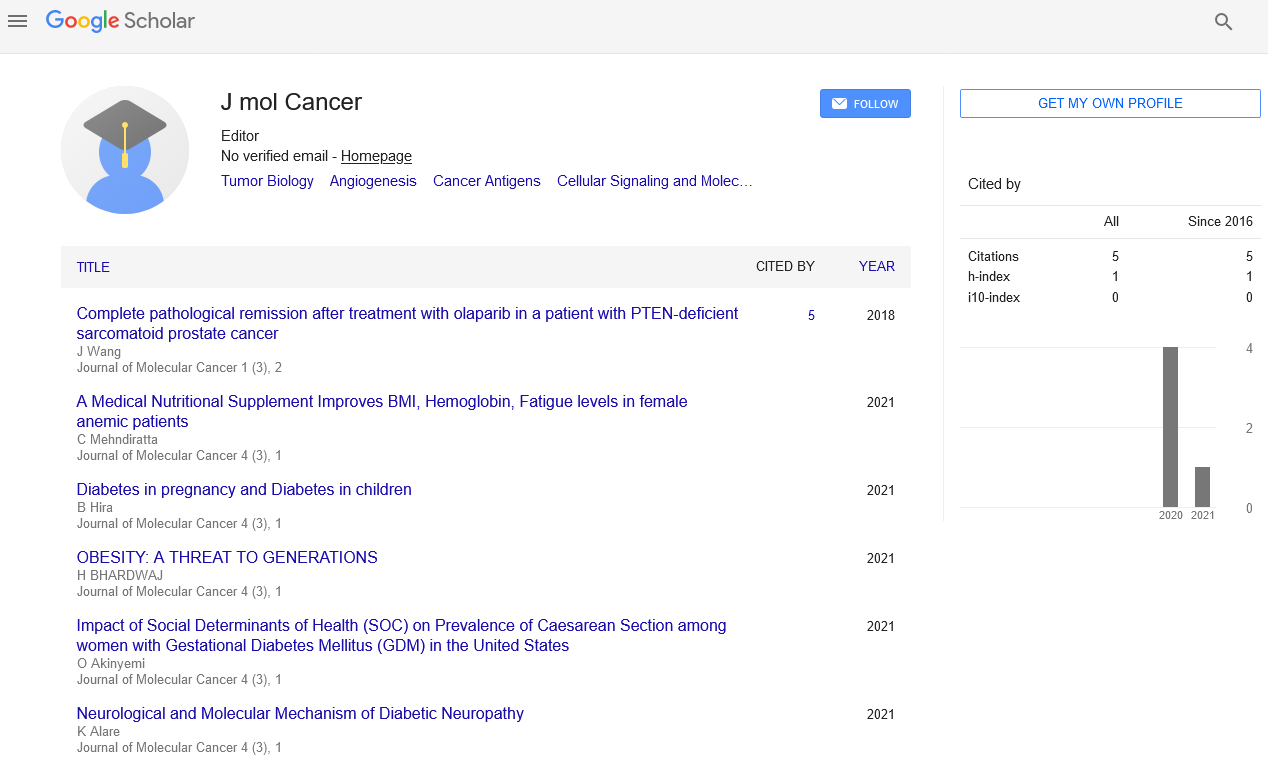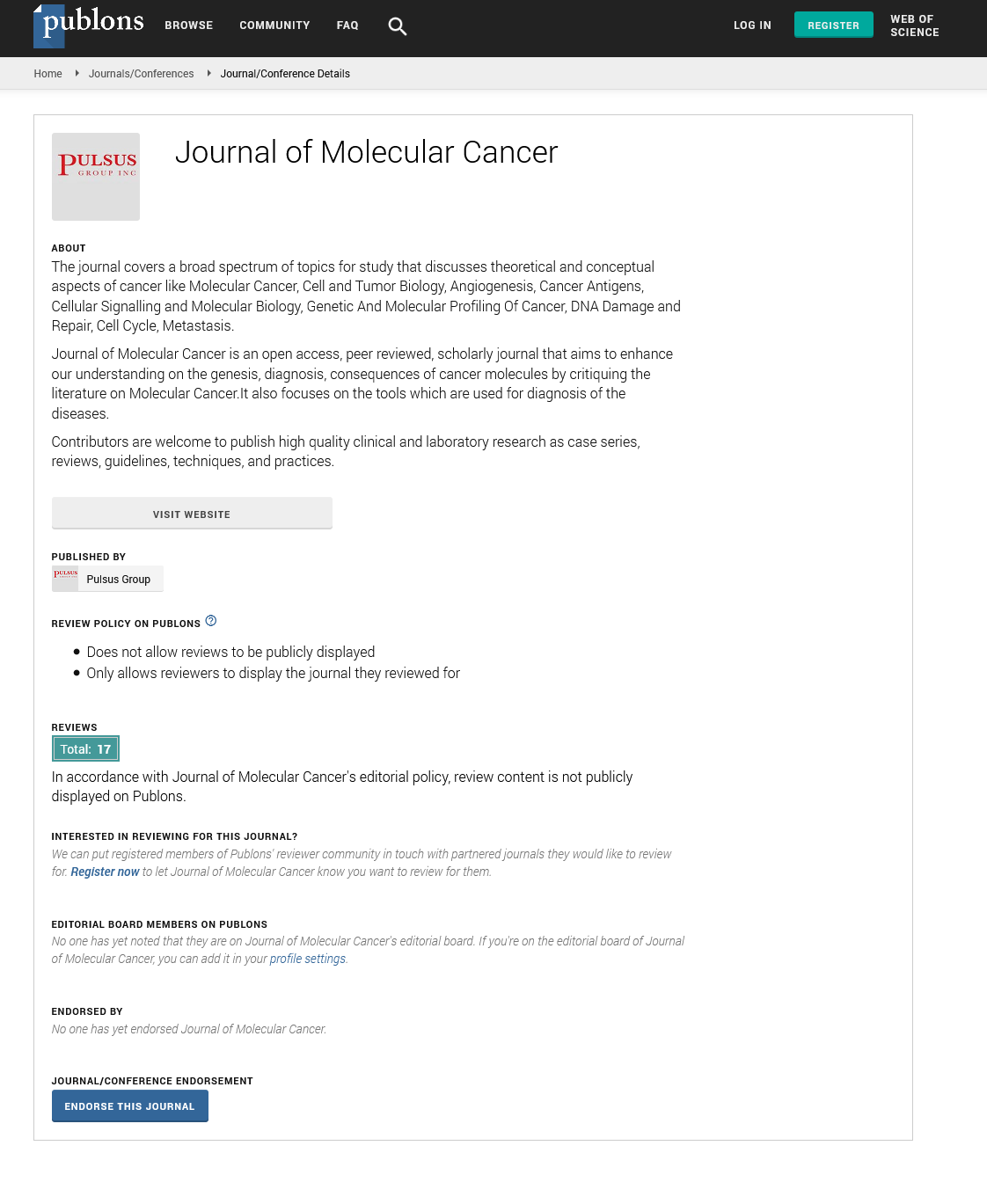Hypoxia: Decreased oxygen levels
Received: 14-Mar-2022, Manuscript No. puljmc-22-4481; Editor assigned: 16-Mar-2022, Pre QC No. puljmc-22-4481(PQ); Accepted Date: Mar 14, 2022; Reviewed: 21-Mar-2022 QC No. puljmc-22-4481(Q); Revised: 25-Mar-2022, Manuscript No. puljmc-22-4481(R); Published: 28-Mar-2022, DOI: DOI:10.37532/puljmc.22.5(2).6-7
Citation: Janssens E. Hypoxia: decreased oxygen levels. J Mol Cancer. 2022; 5(2):6-7.
This open-access article is distributed under the terms of the Creative Commons Attribution Non-Commercial License (CC BY-NC) (http://creativecommons.org/licenses/by-nc/4.0/), which permits reuse, distribution and reproduction of the article, provided that the original work is properly cited and the reuse is restricted to noncommercial purposes. For commercial reuse, contact reprints@pulsus.com
Abstract
Hypoxia is serving significant jobs in tumors. This study plans to thoroughly examine the sub-atomic elements and clinical importance of a distinct hypoxia-related signature in skillet malignant growth utilizing multi-omics information. Information were gained from TCGA, CCLE, GDSC, and GEO. RNA articulation design, duplicate number variety (CNV), methylation, and change of the mark were broke down. Most of the 15 qualities were upregulated in disease tissues contrasted and typical tissue, and RNA articulation was adversely connected with methylation level. CNV happened in practically every one of the tumors, while transformation recurrence was low across various disease types. The mark was likewise firmly connected with malignant growth trademarks and disease related digestion pathways. NDRG1 was upregulated in kidney malignant growth tissues as shown by immunohistochemistry. Also, a large portion of the 15 qualities were risk factors for patients' general endurance. Our outcomes give a significant asset that will direct both unthinking and restorative examinations of the hypoxia signature in malignant growths.
Key Words
Phosphoglycerate mutase; Triosephosphate isomerase; Epithelial-mesenchymal progress; Immunohistochemistry
Introduction
Malignant growth is a significant weight worldwide and is likewise a main source of death. It is a multi-step infection and described by complex organic highlights. Hypoxia, which is characterized as decreased oxygen levels, is one of the signs of threatening growths. The vast majority of the growth cells have inadequate blood supply because of quickly expanding cell expansion and expanding growth mass, coming about in a hypoxic cancer microenvironment, and hypoxia plays an essential part in shaping the way of behaving of tumors. It has been accounted for that hypoxia could make growth cells gain more forceful aggregates. Hypoxia can likewise prompt Epithelial-Mesenchymal Progress (EMT) is firmly connected with growth relocation and attack. Also, hypoxia advances self-reestablishment capacity and stifles the separation of immature microorganisms in specific cancers. Plus, hypoxia is related with unusual vasculature, metastasis, and radiochemotherapy obstruction. A few methodologies, including both obtrusive and painless ones, have been created to gauge growth oxygen levels in cancers. Nonetheless, these techniques have restricted applications. Along these lines a hearty and clinically pertinent hypoxia quality mark has been presented. The mark is made out of 15 qualities with known work: VEGF (Vascular Endothelial Development Factor A), PGAM1 (Phosphoglycerate Mutase 1), ENO1 (Enolase 1), LDHA (Lactate Dehydrogenase A), TPI1 (Triose Phosphate Isomerase 1), P4HA1 (Prolyl 4-Hydroxylase, A-Polypeptide I), MRPS17 (Mitochondrial Ribosomal Protein S17),ADM (Adrenomedullin), NDRG1 (N-myc Downstream Controlled 1), TUBB6 (Tubulin, b6), ALDOA (Aldolase A, Fructose-Bisphosphate), MIF (Macrophage Movement Inhibitory Component), SLC2A1 (Solute Transporter Family 2, part 1), CDKN3 (Cyclin-Subordinate Kinase Inhibitor 3), and ACOT7 (Acyl-CoA Thioesterase 7). The mark is the best entertainer, demonstrated by ongoing broad investigates that have assessed and approved the force of various hypoxia marks.
Genomic alterations of hypoxia-associated signature in different cancertissues
A typical and smaller hypoxia metagene has been recognized and chosen. We dissected the sub-atomic scene of the 15-quality hypoxia signature in different tumors to give essential data to future investigations. We examined CNV, methylation, and change information from TCGA, CCLE, GDSC, and GEO (Database: TCGA, CCLE, GDSC. furthermore, GEO). CNV was seen in all the hypoxia-related qualities, among which NDRG1 and MRPS17 had the most noteworthy addition recurrence across the 33 malignant growth types. The normal change recurrence of the 15 qualities was low, going from 0 to 0.25 with a normal worth of 0.01. The methylation information from TCGA was likewise broke down. The beta worth was utilized to measure methylation status. Methylation was seen in the majority of the 15 qualities with the beta worth reach being 0-0.7. ACOT7, TUBB6, and NDRG1 were the most exceptionally methylated qualities.As quality methylation is firmly corresponded with mRNA articulation, quality articulation information from TCGA and GEO were then dissected. Quality articulation of ordinary tissues and disease tissues was analyzed. Curiously, both TCGA and GEO information showed that lung, kidney, and uterus disease tissues had general higher hypoxia-related quality articulation contrasted and typical tissues. Direct models were additionally used to adapt to growth virtue, ploidy, age, sex, and race. To survey the connection among methylation and quality articulation, the connection was dissected, and it demonstrated that there was a converse connection between RNA articulation and methylation level in a large portion of the 33 malignant growth types. Specifically, RNA articulation information from LUSC were additionally investigated, and it showed that 14 of the 15 qualities were fundamentally upregulated in malignant growth tissues contrasted and ordinary tissue with p<0.001. As NDRG1 was fundamentally upregulated in kidney malignant growth tissues in both GEO and TCGA information, we approved the outcomes in tissues by Immunohistochemistry (IHC). It showed that NDRG1 was fundamentally higher in kidney malignant growth tissues.
Discussion
In our review, we extensively investigated multi-omics information of hypoxia-related signature. Metabolomics, transcriptomics, epigenetics, and proteomics information are incorporated to explore the job of the hypoxia-related signature in tumors in a broad way. Multi-omics information empowers us to anticipate novel utilitarian collaborations between sub-atomic arbiters at different levels. Likewise, this information can possibly uncover essential organic perceptions into trademarks and pathways that would some way or another not be clear through single-omics studies. Hypoxia has been given wide consideration as of late. Cancer tests into hypoxia scorehigh and score-low gatherings in light of the very hypoxia signature and recognized atomic adjustments that associated with drug reactions to anticancer medications. Be that as it may, atomic depiction of the 15-quality hypoxia signature in malignant growth tissues and cell lines is as yet inadequate. Our review played out a far reaching investigation of the hypoxia signature, meaning to give a valuable asset to future related explores.
Conclusion
We deliberately broke down the scene of hereditary, epigenetic, and metabolomics adjustments and organic and clinical pertinence of hypoxia-related signature in tumors. It assists with bettering get the dysregulation of hypoxia in malignant growth. The discoveries from our review can be promptly applied to additional examinations and We deliberately broke down the scene of hereditary, epigenetic, and metabolomics adjustments and organic and clinical pertinence of hypoxia-related signature in tumors. It assists with bettering get the dysregulation of hypoxia in malignant growth. The discoveries from our review can be promptly applied to additional examinations and are exceptionally encouraging for customized treatment regimens and clinical administration. We likewise took a gander at the methylation level of the 15 qualities across all the 33 disease types. The methylation level of the mark is comparable in 30 of the 33 malignant growth types, showing the homogeneity of the mark in tumors. DNA methylation in the quality body should increment quality articulation, while advertisers' methylation is adversely connected with quality articulation. The negative relationship between's RNA articulation and methylation status for most of the qualities uncovers that advertiser methylation is normal for these qualities, and methylation inhibitors may be utilized in light of the assumed remedial objective, especially on account of NDRG1, TUBB6, and ACOT7.






